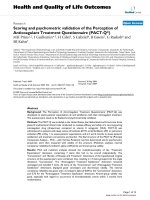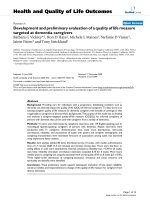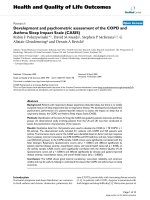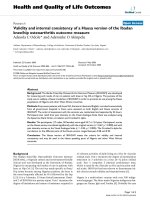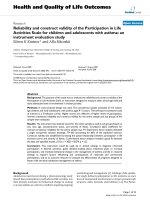báo cáo hóa học:" Growth and structure analysis of tungsten oxide nanorods using environmental TEM" doc
Bạn đang xem bản rút gọn của tài liệu. Xem và tải ngay bản đầy đủ của tài liệu tại đây (1.34 MB, 7 trang )
NANO EXPRESS Open Access
Growth and structure analysis of tungsten oxide
nanorods using environmental TEM
Tomoharu Tokunaga
1*
, Tadashi Kawamoto
1
, Kenta Tanaka
1
, Naohiro Nakamura
1
, Yasuhiko Hayashi
2
,
Katsuhiro Sasaki
1
, Kotaro Kuroda
1
and Takahisa Yamamoto
1
Abstract
WO
3
nanorods targeted for applications in electric devices were grown from a tungsten wire heated in an oxygen
atmosphere inside an environ mental transmission electron microscope, which allowed the growth process to be
observed to reveal the growth mechanism of the WO
3
nanorods. The initial growth of the nanorods did not
consist of tungsten oxide but rather crystal tungsten. The formed crystal tungsten nanorods were then oxidized,
resulting in the formation of the tungsten oxide nanorods. Furthermore, it is expected that the nanorods grew
through cracks in the natural surface oxide layer on the tungsten wire.
Keywords: tungsten, oxide, nanorod, environmental TEM
Background
Metal oxides such as ZnO, In
2
O
3
,andWO
3
are well
known as bandgap semiconductors, which led to the
development of many growth me thods. During the stu-
dies into these growth methods, nanoscale metal oxides
were discovered. These nanoscale materials have been
widely studied since the electronic characteristics of
nanoscale materials are different from those of bulk-
scale materials [1-5]. In particular, metal oxides with
nanorod structures were studied because they have a
one-dimensional structure and are thus able to b e
applied for electrical components such as nanoscale
wires. Tungsten oxide nanorods are one of the metal
oxide semiconductors that can be easily made [6-8].
Therefore, due to its semiconducting properties, it is
applied in electrical devices. However, the growth
mechanism of tungsten oxide nanorods has not yet been
clarified, and the growth of tungsten oxide nanorods has
not been successfully controlle d. In this study, the tung-
sten oxide nanorod growth process was observed using
an environmental transmission electron microscope
[TEM], and the growth mechanism was examined.
Methods
The growth of tungsten oxide nanorods was conducted
by heating a tungsten wire in an oxygen atmosphere
inside an environmental TEM. The commercially
obtained pure tungsten wir e (wire diameter, 25 μm; pur-
ity, 99.99%; The Nilaco Corporation, Tokyo, Japan) was
used as the primary material for the tungsten oxide
nanorods, and the heate r, for the wire-heated environ-
mental TEM sample holder, which enabled the introduc-
tion of gas into the environmental TEM. The holder was
equipped with electrodes and the gas-introducing nozzle;
the tungsten wire was connected between the electrodes
and heated by current being applied to the wire. The
measurement of the temperature of the heated wire was
attempted using both a th ermocouple and radiation ther-
mometer. However, due to the small size of the wire, the
thermocouple could not touch the wire. Furthermore,
the measurement area of a radiation thermometer is lar-
ger than the wire diameter; therefo re, space and material
other than the wire was included in the measurement
area. As a result, the wire temperat ure could not be mea-
sured by either the thermocouple or the radiation ther-
mometer. Consequently, the wire temperature was
measured using the following method. First, a pure metal
powder with a known melting point was set on the con-
nected wire. Secondly, the holder was introduced into the
environmental TEM and the wire was heated. Then, the
current was recorded when the metal powder melted; the
* Correspondence:
1
Department of Quantum Engineering, Nagoya University, Furo-cho, Chikusa-
ku, Nagoya, Aichi, 464-8603, Japan
Full list of author information is available at the end of the article
Tokunaga et al. Nanoscale Research Letters 2012, 7:85
/>© 2012 Tokunaga et al; licensee Springer. This is an Open Access article distributed under the terms of the Creative Commons
Attribution License ( which permits unrestricted use, distribution, and reproduction in
any medium, provided the original work is properly cited.
same procedure was repeated with other metal powders.
Finall y, the temperature at which each metal melted was
plotted on a current-temperature graph. This graph
allowed us to determine the wire temperature without a
thermocouple or radiation thermometer. The sample-
heating holder was inserted in the environmental TEM,
and the pressure in the environmental TEM was regu-
lated by flow-rate control of t he injected oxygen gas
through the nozzle. The tungsten oxide nanorods grew
after the current flowed through the tungsten wire. The
environmental TEM used in the present study was made
by HITACHI (H-9000NAR, Tokyo, Japan) and was
equipped with a Gatan imaging filter [GIF] (Tokyo,
Japan), a CCD, and a camera. This machine was operated
at an accelerating voltage of 300 kV. The GIF was used
to determine the elemental maps and electron energy
loss spectra of the samples, and the dynamic growth
behavior of the samples was recorded by the camera. The
growth conditions used were as follows: the wire tem-
perature was 800°C, and the oxygen pressure in the
environmental TEM was 1.0 × 10
-4
Pa. These growth
conditions were applied for all the samples grown. More-
over, the existence and shape of the grown material on
the w ire were observed by scanning electron microscopy
[SEM] (HITACHI, S-4300). The wire was removed from
the TEM holder for the SEM observations. In thick crys-
talline tungsten, it is difficult to observe the natural sur-
faceoxidelayeronthewireandthebehaviorofthe
interface between the nanorods and wire due to the diffi-
culty of the transmission of electrons for TEM analyses.
In this case, a part of the tungsten wire was fabricated
into a thin film, in which electrons can transmit through,
by a focused ion be am [FIB] (JEM-9320FIB, JEOL Ltd.,
Akishima, Tokyo, Japan). The FIB was operated at an
accelerating voltage of 20 kV.
Results and discussion
SEM images of the tung sten wire that was heated in an
oxygen atmosphere and the non-heated wire are shown
in Figure 1; the heating time was 10 min. Both the
heated and non-heated wires have as perity, which origi-
nated in the wiredrawing die when the tungsten bulk
was processed from ingot to wire. In comparing the dif-
ferences between the heated and the non-heated wire, it
was recognized that tw o types of growth structures exist
on the heated wire: one is nanorods with an average
length and diameter of about 100 and 15 nm, respec-
tively, while the other is a blunt angle, isosceles triangle-
like plate. However, t here were f ew of t he latter st ruc-
tures on the wire, so the nanorods were the primary
focus. The growth materials, which were locat ed on the
same asperity surface, were mutually parallel. It is pro-
posed that the reason for this is that the direction of
material growth was dependent on the bottom crystal
face, which was the same as the asperity surface on the
wire. In addition, nanometer-sized bright contrasts were
confirmed in F igure 1, and they were showed by white
arrows. It was inferred t hat these contrasts were
nanorod and triangle-like structures during growth.
Elemental mapping was carried out to examine the
material of the n anorod using the energy filter of the
TEM. The TEM images and oxygen and tungsten map-
pings are shown in Figure 2. Nanorods with diameters of
about 10 to 20 nm and various lengths were confirmed in
the TEM image in Figure 2a. Oxygen and tungsten map-
pingsofFigure2aareaareshowninFigure2b,c.The
existence of tungsten and oxygen was detected in the
nanorod area in Figure 2a, which confirmed that the
nanorods were made from tungsten oxide. The tungsten
wire was located at the base of the tungsten oxide nanorod
shown in the lower right of Figure 2a.
High-resolution TEM [HRTEM] images and selected
area electron diffraction [SAED] of the nanorods were
obtained to reveal the crystal structure and orientation of
the nanorod (Fig ure 3). The HRTEM image of the t ung-
sten oxide nanorod (marked by a broken-line circle) in
Figure 3b correlates with that in the TEM image shown
in Figure 3a. Regularly aligned lattice dots, which exist
Figure 1 SEM images of the heated and non-heated tungsten wire.
Tokunaga et al. Nanoscale Research Letters 2012, 7:85
/>Page 2 of 7
along the longer directional axis and perpendicular axis
against longer direction of the nanorod in Figure 3b,
were confirmed in Figure 3a. Lattice dots were aligned in
intervals of 0.38 nm in the longer directional axis of the
nanorods and in intervals of 0.37 nm in the perpendicu-
lar direction to the longer direct ional axis. These interval
distances of 0.38 and 0.37 nm correlate to the distances
of (002) and (020) of WO
3
, which has a monoclinic crys-
tal structure (Joint Committee on Powd er Diffraction
Standards [JCPDS] card no. 83-0951). These results and
elemental mapping revealed that the nanorods grown
from tungsten wire comprise WO
3
with a monoclinic
sys tem. As shown in Figur e 3c, two different cyclic spots
existed in the SAED pattern. One cyclic spot aligned with
the A vector, which correlates with the longer direction
of the nanorod, and the other cyclic spot aligned with the
B vector, which correlates with the direction perpendicu-
lar to the longer direction of the nanorod. The latter cyc-
lic spot has two different brightness intensities with a
weaker cyclic spot shift of the B vector from the strong
cyclic spot. However, spot shift was not observed in the
cyclic spot aligned with the A vector. This phenomenon
indicates that dislocation exists only in the parallel plane
in the longer direction of the nanorod, but not in the
perpendicular plane against the longer direction of the
nanorod. Dislocations were apparent in Figure 3a, as
indicated by the broken white lines along the longer
direction of the nanorods. It is proposed that the moder-
ate shift of the lattice dots at the broken wh ite line is due
to dislocation.
The above results reveale d the material and structure
of the nanorod. Additionally, TEM observation of the
initial WO
3
nanorod growth was conducted to investi-
gate the growth mechanism. TEM and HRTEM images
of the surface of the non-heated tungsten wire and a
nanorod that was halted in the initial growth stage are
showninFigure4.InFigure4a,whichpresentsthe
appearance of the non-heated tungsten wire surface, it
is shown that a 2-nm-thick amorphous layer was coated
perfectly on the surface of the tungsten wire. This thin
layer was speculated to be natural tungsten oxide. In
Figure 4b, which shows the surface of tungsten wire in
the initial growth stage, prominences with similar widths
appeare d on the surface of the tungsten wire. Moreover,
the result of the observed prominence root area under
high magnification is shown in Figure 4c, which shows
that lattice fringes with distances of 0.22 nm exist con-
tinuously in the prominences and tungsten wire. This
Figure 2 TEM image and elemental mapping of the nanorods.(a) TEM image. (b) O map. (c) W map.
Tokunaga et al. Nanoscale Research Letters 2012, 7:85
/>Page 3 of 7
Figure 3 HRTEM image (a), TEM image (b), and SAED pattern (c) of the tungsten oxide nanorod.
Figure 4 TEM of tungsten nanowire and HRTEM and TEM images o f the nanorod .(a)TEMimagearoundthesurfaceofnon-heated
tungsten wire. (b, c) TEM and HRTEM images of the initial growth of the nanorod, respectively.
Tokunaga et al. Nanoscale Research Letters 2012, 7:85
/>Page 4 of 7
fringe distance conforms to (110) of tungsten, as indi-
cated in JCPDS c ard no. 04-0806, so the prominence is
thought to be constructed of crystal tungsten. An amor-
phous oxide layer was observed on the surface of the
tungsten wire where the nanorod did not grow, but that
amorphous layer was not observed on the top of the
prominence (Figure 4b). These results indicate th at a
heaving bottom wire was not the origin of this promi-
nence. Furthermore, tungsten does not exist in vapor
form, so the prominence could not have been formed
from accumulating tungsten from vapor. Here, the pro-
cess of the prominence appearing is assessed. When the
tungsten wire was heated at 800°C, the wire expanded.
However, the wire had an amorphous oxide layer on the
surface. The thermal expansion coefficients of tungsten
and amorphous tungsten oxide are about 4.5 × 10
-6
and
12 × 10
-6
[9], respectively; therefore, amorphous tung-
sten oxide is more likely to expand than tungsten. How-
ever, the volume of the surface amorphous oxide layer
is much smaller than that of the tungsten under the sur-
face oxide layer, so the volume expansion of tungsten is
much larger than that of the amorphous oxide layer
when the tungsten wire is heated. Tungst en oxide has a
hardness of between 5 and 7 GPa at around 800°C [10],
but the layer is fra ctured and thin and it is expected
that cracks formed in the oxide layer. As a result, the tung-
sten under the oxide layer was exposed to a decompres-
sion atmosphere, forcing tungsten to diffuse through the
cracks in the oxide layer by t hermal expansion stress-
induced diffusion and form the tungsten prominence. The
reason that prominences were not formed at the area cov-
ered by the amorphous oxide layer when the wire was
heated is thought to be that it is more difficult for tung-
sten to diffuse onto the surfa ce when it is covered by the
oxide layer. Lee et al. heated a tungsten film to 850°C to
obtain a crystal tungsten nanowire with a length of over 1
μm [11]. Their growth conditions are similar to ours with
the exception of the atmospher ic gas. Therefore, the rea-
son that our nanorods comprised tungsten oxide is oxida-
tion by oxygen as the atmospheric gas. Since the
prominence comprises tungsten during the initial growth
stage and the atmospheric gas is oxygen, it is suggested
that the tungsten prominence initially grew followed by
oxidization. After that, WO
3
nanorods were grown. If
cra cks occu rred in the surface oxide layer when t he wire
was heated, the formation of the prominence by tungsten
diffusing through the cracks is expected. However, tung-
sten, with a hardness of about 2 GPa, is very hard [10], so
the possibility of prominence growth occurring via tung-
sten deformation only at the crack area is low. Addition-
ally, the melting point of tungsten is 3,422°C, which is
much higher than the growth process temperature of
nanorods [12]. Hence, it is unlikely that tungsten evapo-
rated through the cracks. From the TEM and HRTEM
observations, it is most likely that cracks occurred in the
oxide layer, and then the tungsten prominence grew
through the cracks, as presented above.
Environmental TEM images of the growing WO
3
nanorod observed from [100] and [010] to reveal the
WO
3
nanorod middle growth mechanism are shown in
Figure 5. Steps pointed by white arrows in Figure 5a were
confirmed on the edge of the nanorods; the steps grew
and moved to the top o f the nanorods, as observed from
the [100] direction in Figure 5a. The steps were not con-
firmedontheedgeofthenanorodobservedfromthe
[010] direction. Instead, a changing contrast line marked
by white arrows that gradually moved to the top of the
nanorods was present, as shown in Figure 5b. This line
was proposed to be the edge step of the nanorod
observed from the [100] direction. These results indicate
that the plane on (010) grows preferentially during WO
3
nanorod growth.
The growth mechanism has often been discussed in
other papers written about the growth of nanorod struc-
tures; the vapor-liquid-solid [VLS] and vapor-solid [VS]
growth mechanisms are well known [13]. The VLS growth
mechanism is the method in which the vapor is melted in
a catalyst and then segregated. The VS mechanism is the
method in which the ori ginal sources are dissolved in
vapor and then crystals formed on the substrate. Catalysts
are needed for VLS growth, and there were no catalysts on
the top of the nanorod in Figure 5a. Therefore, the growth
mechanism of the WO
3
nanorod was not VLS. Moreover,
origin gases are needed in the case of the VS mechanism.
In this study, the only origin gas was oxygen, and tungsten
gas was not introduced in the environmental TEM. The
possibility of the evaporationoftungstenoxide,which
existed originally or formed by heating in oxygen on the
wire, was imagined. However, the heating temperature
was 800°C, which is lower than the required 1,400°C for
the evaporation of tungsten oxide [14]. As a result, the VS
growth mechanism was not reasonable for the nanorod
growth mechanism. In this study, the oxygen and tungsten
originated from vapor and tungsten wire, respectively, so
it is presumed that the tungsten, which was supplied from
thetungstenwire,wasoxidizedbyoxygeninvapor,and
then WO
3
nanorods were grown on the wire. These delib-
erations and results show that WO
3
nanorods are grown
from the tungsten prominence seen in Figure 4b by lateral
growth.
Next, the growth of WO
3
nanorods from the tungsten
prominence is discussed. Engel et al. investigated the
tungsten face that most easily absorbed oxygen and
determined that the (110) face of tungsten absorbed the
most oxygen [15]. Figure 4 suggests that the side edge of
the prominence was (110) of tungsten and oxygen
abso rbed preferentially on (110). It was also inferred that
WO
3
formed preferentially on (110) of the edge of the
Tokunaga et al. Nanoscale Research Letters 2012, 7:85
/>Page 5 of 7
tungsten prominence, and then oxygen absorbed on the
(010) face of the WO
3
formed on the tungsten promi-
nence. After that, the (010) and (001) faces o f WO
3
,
which absorbed oxygen easily and are the closest and
close-packed planes [16], grew. The origin of the tung-
sten is the bottom of the tungsten wire, so this acts as
the tungsten supply for the nanorods. Therefore, the
growth of WO
3
on the edge of the nanorod starts from
the bottom to the top of the nanorod. The reason that
WO
3
nanorod growth disappears at the area covered by
the natural oxide layer when the tungsten wire was
heated is that the tungsten prominence, which has the
planes that easily absorb oxygen, do not grow.
In summary, the mechanism of the WO
3
nanorod
growth was determined to be as follows: cracks occurred
in the surface of the natural tungsten oxide lay er when
the tungsten was heated, after which tungsten diffused
through the cracks of natural tungsten oxide layer from
the tungsten wire to form a highly crystalline promi-
nence. The (11 0) plane of the tungsten prominence was
preferentially oxidized to form WO
3
. T ungsten and oxy-
gen are supplied to the WO
3
surface from the bottom
tungsten wire and atmosphere, respectively, resulting in
continual growth of the WO
3
nanorods. To obtain
further evidence for the proposed growth mechanism, a
part of the oxide layer on the tungsten substrate needs
to be fine-fabricated by FIB, electron beam lithography,
etc., and then heated in an oxygen atmosphere, and the
appearance of WO
3
nanorod growth will have to be
confirmed.
Conclusions
WO
3
nanorods were grown by heating a tungsten wire
in an oxygen atmosphere, and the growth of WO
3
was
observed by environmental TEM an d HRTEM. In parti-
cular, the initial and the middle growth were observed.
The growth mechanism involving the initial formation
of cracks in the surface natural oxide layer on the tung-
sten wire followed by the formation of a tungsten pr o-
minence that was subsequently oxidized to form the
WO
3
nanorods was proposed. The tungsten and o xygen
were supplied from the tungsten wire and the oxygen
atmosphere, respectively. WO
3
nanorod growth was
suggested by TEM observation.
Acknowledgements
This work is supported by a research grant from the Murata Science
Foundation and a Grant-in-Aid for Young Scientists (B program, no.
22760537) from the Ministry of Education, Culture, Sports, Science and
Technology, Japan.
Author details
1
Department of Quantum Engineering, Nagoya University, Furo-cho, Chikusa-
ku, Nagoya, Aichi, 464-8603, Japan
2
Department of Frontier Materials,
Nagoya Institute of Technology, Gokiso-cho, Showa-ku, Nagoya, Aichi, 466-
8555, Japan
Authors’ contributions
TT carried out the TEM observation with TK and KT, and drafted the
manuscript. TK and KT controlled the environmental condition in
environmental TEM when the sample was observed. NN carried out the
sample preparation by FIB. YH participated in the design of the sample
preparation. KS performed the heater calibration and maintained the
environmental TEM. KK participated in the study design. TY coordinated this
work. All authors read and approved final manuscript.
Figure 5 Environmental TEM images of the growing WO
3
nanorod observed from [100] (a) and [010] (b).
Tokunaga et al. Nanoscale Research Letters 2012, 7:85
/>Page 6 of 7
Competing interests
This work was supported by a Grant-in-Aid for Young Scientists (B program,
no. 22760537) and a research grant from the Murata Science Foundation.
Received: 28 November 2011 Accepted: 25 January 2012
Published: 25 January 2012
References
1. Ocana M, Morales MP, Serna C: The growth of α-Fe
2
O
3
ellipsoidal particles
in solution. J Coll and Inter Sci 1995, 171:85-91.
2. Dai Y, Zhang Y, Li QK, Nan CW: Synthesis and optical properties of
tetrapod-like zinc oxide nanorods. Chem Phys Lett 2002, 358:83-86.
3. Berger O, Fischer WJ, Melev V: Tungsten-oxide thin films as novel
materials with high sensitivity and selectively to NO
2
,O
3
and H
2
S. Part I:
preparation and microstructural characterization of the tungsten-oxide
thin films. J Mater Sci: Mater in Electro 2004, 15:463-482.
4. Hiralal P, Unalan HE, Wijayantha KGU, Kursumovic A, Jefferson D,
MacManus-Driscoll JL, Amaratunga GAJ: Growth and process conditions of
aligned and patternable films of iron(III) oxide nanowires by thermal
oxidation of iron. Nanotechnology 2008, 19:455608-455614.
5. Li ZL, Liu F, Xu NS, Chen J, Deng SZ: A study of control growth of three-
dimensional nanowire networks of tungsten oxides: from aligned
nanowires through hybrid nanostructures to 3D networks. J Cry Growth
2010, 312:520-526.
6. Gu G, Zheng B, Han WQ, Roth S, Liu J: Tungsten oxide nanowires on
tungsten substrates. Nano Lett 2002, 2 :849-851.
7. Vaddiraju S, Chandrasekaran H, Sunkara MK: Vapor phase synthesis of
tungsten nanowires. J Am Chem Soc 2003, 125:10792-10793.
8. Liu Z, Bando Y, Tang C: Synthesis of tungsten oxide nanowires. Chem
Phys Lett 2003, 372:179-182.
9. Weast RC: CRC Handbook of Chemistry and Physics Boca Raton: CRC Press;
1988.
10. Lee M, Flom DG: Hardness of polycrystalline tungsten and molybdenum
oxides at elevated temperatures. J Am Ceram Soc 1990, 7:2117-2118.
11. Lee YH, Choi CH, Jang YT, Kim EK, Ju BK: Tungsten nanowires and their
field electron emission properties. App Phys Lett 2002, 81:745-747.
12. Massalski TB, Murray JL, Bennett LH, Baker H: Binary Alloy Phase Diagram
Materials Park: American Society for Metals; 1986.
13. Wagner RS, Ellis WC: Vapor-liquid-solid mechanism of single crystal
growth. App Phys Lett 1964, 4:89-90.
14. Samsonov GV: The Oxide Handbook New York: IFI/Plenum Data Corporation;
1973.
15. Engel T, Hagen TVD, Bauer E: Adsorption and desorption of oxygen on
stepped tungsten surfaces. Surf Sci 1977, 62:361-378.
16. Li YB, Bando Y, Golberg D, Kurashima K: WO
3
nanorods/nanobelts
synthesized via physical vapor deposition process. Chem Phys Lett 2003,
367:214-218.
doi:10.1186/1556-276X-7-85
Cite this article as: Tokunaga et al.: Growth and structure analysis of
tungsten oxide nanorods using environmental TEM. Nanoscale Research
Letters 2012 7:85.
Submit your manuscript to a
journal and benefi t from:
7 Convenient online submission
7 Rigorous peer review
7 Immediate publication on acceptance
7 Open access: articles freely available online
7 High visibility within the fi eld
7 Retaining the copyright to your article
Submit your next manuscript at 7 springeropen.com
Tokunaga et al. Nanoscale Research Letters 2012, 7:85
/>Page 7 of 7



